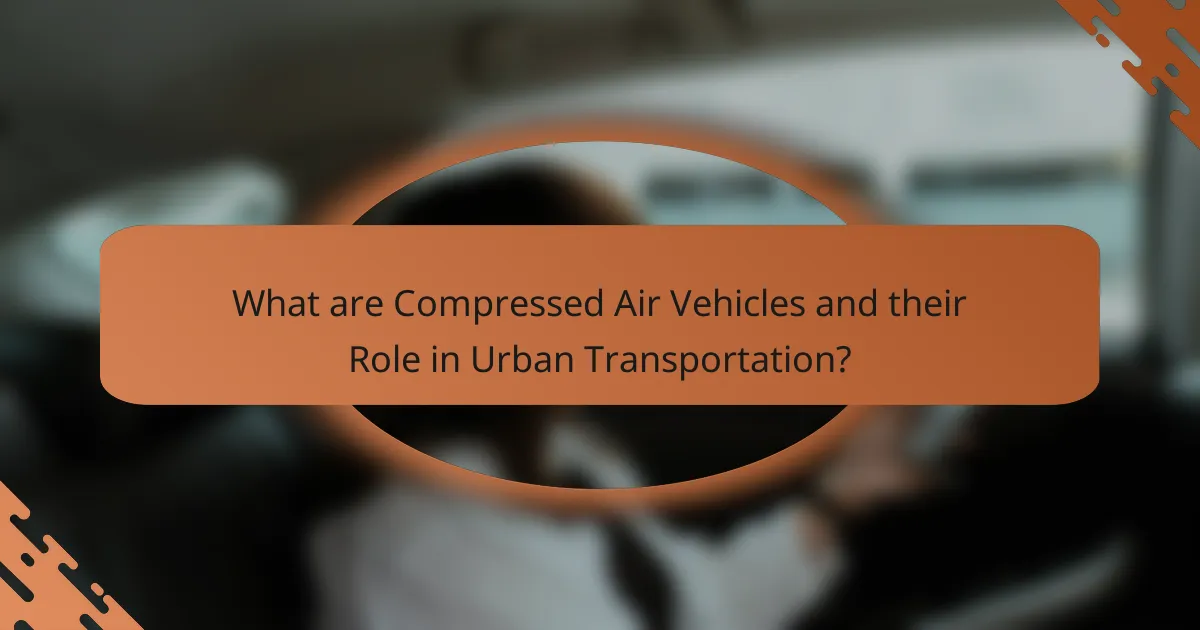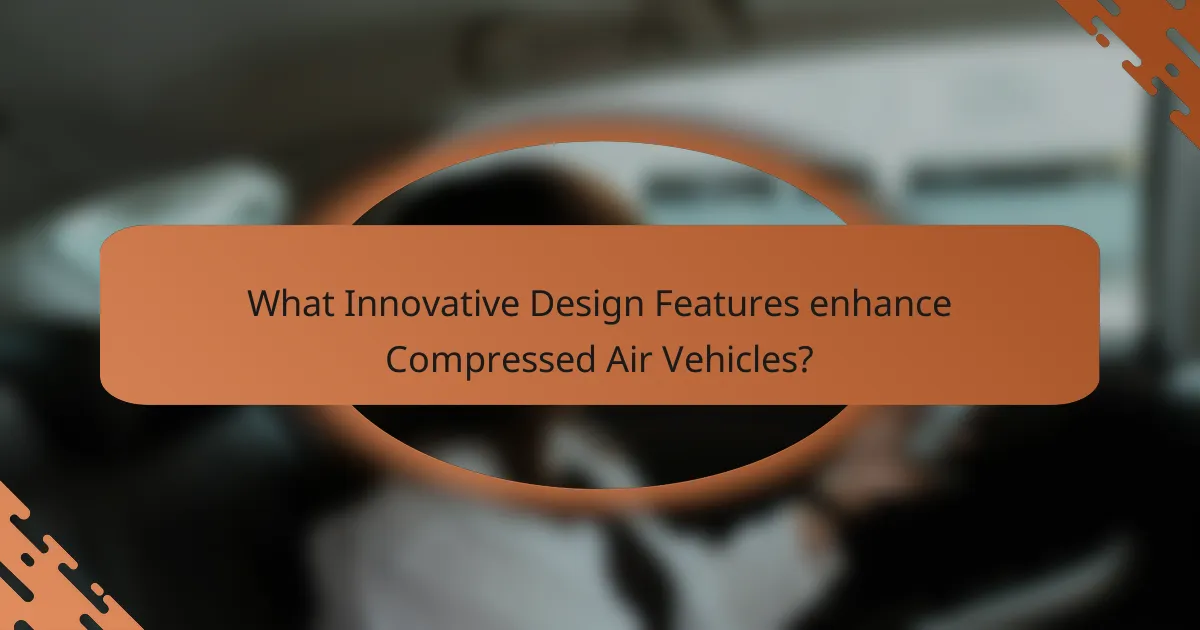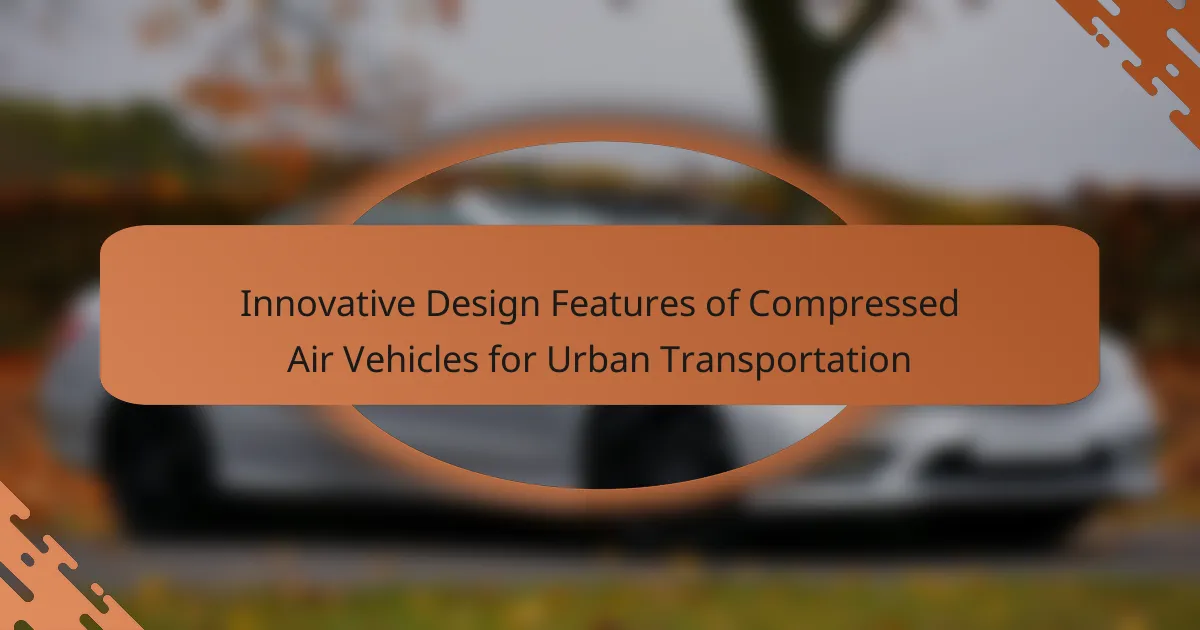Compressed air vehicles (CAVs) are innovative vehicles powered by compressed air, offering a sustainable alternative to traditional transportation methods. This article explores the design features that enhance the efficiency and performance of CAVs, including lightweight materials, efficient air storage systems, and advanced aerodynamics. It highlights the environmental benefits of CAVs, such as zero emissions and reduced greenhouse gas output, as well as their potential to lower operating costs and alleviate urban traffic congestion. The future of CAVs in urban transportation is promising, with ongoing research and development aimed at improving their practicality and integration into sustainable transport solutions.

What are Compressed Air Vehicles and their Role in Urban Transportation?
Compressed air vehicles (CAVs) are vehicles powered by compressed air as a source of energy. These vehicles utilize compressed air stored in tanks to drive pistons or turbines, converting the air’s energy into mechanical power. CAVs are considered environmentally friendly as they produce zero emissions during operation. Their role in urban transportation includes reducing air pollution and dependence on fossil fuels.
Moreover, CAVs can offer lower operating costs compared to traditional vehicles. They can be refueled quickly at designated stations, making them suitable for urban environments. Research indicates that CAVs can help alleviate traffic congestion by providing an alternative mode of transport. Studies show that implementing CAVs in cities can lead to a significant decrease in greenhouse gas emissions.
How do Compressed Air Vehicles operate?
Compressed Air Vehicles operate by using compressed air as a power source for propulsion. They store compressed air in tanks, which is then released to drive pistons or turbines. This process generates mechanical energy to move the vehicle. The air is compressed using an external compressor or through regenerative braking. Compressed air is environmentally friendly, producing zero emissions during operation. Studies show that compressed air can provide sufficient energy for urban transportation needs. For example, a compressed air vehicle can achieve a range of approximately 100 miles on a full tank.
What are the key components of Compressed Air Vehicles?
The key components of compressed air vehicles include the air storage tank, air compressor, propulsion system, and control system. The air storage tank holds compressed air, which is essential for vehicle operation. The air compressor is responsible for compressing ambient air into the storage tank. The propulsion system converts the compressed air into mechanical energy to drive the vehicle. The control system manages the operation of these components, ensuring efficient performance. These components work together to enable the vehicle to operate using compressed air as a clean energy source.
How does the air compression process work in these vehicles?
The air compression process in compressed air vehicles involves the intake of ambient air, which is then compressed using a mechanical compressor. This compression increases the air’s pressure and density, storing it in high-pressure tanks. When the vehicle operates, the compressed air is released through a nozzle or turbine. This release propels the vehicle forward by converting the stored energy into kinetic energy. The efficiency of this process is enhanced by the vehicle’s design, which minimizes air resistance and maximizes propulsion. Compressed air vehicles utilize this process to achieve low-emission urban transportation.
What are the environmental benefits of using Compressed Air Vehicles?
Compressed Air Vehicles (CAVs) offer significant environmental benefits. They produce zero tailpipe emissions during operation. This reduces air pollution, contributing to improved urban air quality. CAVs utilize compressed air as a clean energy source. This helps decrease reliance on fossil fuels. According to a study by the International Energy Agency, CAVs can lower greenhouse gas emissions significantly. The reduction in noise pollution is another advantage, as CAVs operate quietly. This creates a more pleasant urban environment. Overall, CAVs promote sustainable transportation solutions.
How do Compressed Air Vehicles reduce emissions compared to traditional vehicles?
Compressed Air Vehicles (CAVs) significantly reduce emissions compared to traditional vehicles by utilizing compressed air as their primary power source. Traditional vehicles typically rely on fossil fuels, which release carbon dioxide and other harmful pollutants during combustion. In contrast, CAVs operate with zero tailpipe emissions, as they emit only air. This shift from combustion to air propulsion eliminates greenhouse gas emissions associated with fuel consumption. According to research conducted by the International Journal of Hydrogen Energy, CAVs can reduce carbon emissions by up to 90% in urban environments. This substantial reduction contributes to improved air quality and a decrease in urban pollution levels.
What impact do Compressed Air Vehicles have on urban air quality?
Compressed Air Vehicles (CAVs) significantly improve urban air quality. They produce zero tailpipe emissions, reducing pollutants like nitrogen oxides and particulate matter. This leads to cleaner air in densely populated areas. Studies indicate that replacing conventional vehicles with CAVs can lower urban smog levels. For instance, a report by the International Energy Agency highlights that adopting CAV technology could decrease urban air pollution by up to 50%. Additionally, CAVs contribute to noise reduction, further enhancing urban living conditions. Overall, CAVs represent a sustainable alternative for urban transportation, positively impacting air quality.
What challenges do Compressed Air Vehicles face in urban environments?
Compressed Air Vehicles face several challenges in urban environments. Limited range is a significant issue, as they typically can only travel short distances before needing to recharge. Urban infrastructure may not support the refueling requirements of these vehicles, leading to inconvenience for users. Additionally, compressed air technology often struggles with efficiency in stop-and-go traffic, which is common in cities. The vehicles may also face regulatory hurdles, as existing laws may not accommodate their unique characteristics. Furthermore, noise pollution from compressors can be a concern in densely populated areas. Lastly, public acceptance and awareness of compressed air vehicles remain low, hindering widespread adoption.
How does infrastructure affect the adoption of Compressed Air Vehicles?
Infrastructure significantly impacts the adoption of Compressed Air Vehicles (CAVs). Adequate refueling stations are essential for the practical use of CAVs. Currently, there are limited locations for compressed air refueling. This scarcity hampers consumer confidence in using CAVs for daily transportation. Furthermore, existing roadways may not support the unique operational needs of CAVs. For instance, CAVs require specific maintenance facilities that are not widely available. Additionally, urban planning must incorporate designated lanes for CAVs to optimize their efficiency. A lack of such infrastructure can lead to slower adoption rates. Studies show that regions with supportive infrastructure see higher adoption rates of alternative fuel vehicles. Therefore, enhancing infrastructure is crucial for promoting the use of Compressed Air Vehicles.
What are common misconceptions about Compressed Air Vehicles?
Common misconceptions about compressed air vehicles include the belief that they are not environmentally friendly. In reality, these vehicles produce zero emissions during operation. Another misconception is that they have limited range. Many models can travel over 100 miles on a single tank of compressed air. People often think that compressed air vehicles are underpowered. However, advancements in technology have improved their performance significantly. Some believe they are too expensive to produce. In fact, the production costs are decreasing as technology advances. Lastly, there is a notion that compressed air vehicles are not practical for everyday use. Yet, they are being tested and implemented in various urban settings worldwide.

What Innovative Design Features enhance Compressed Air Vehicles?
Innovative design features that enhance compressed air vehicles include lightweight materials, efficient air storage systems, and advanced aerodynamics. Lightweight materials reduce overall vehicle weight, improving energy efficiency. Efficient air storage systems, such as high-pressure tanks, enable longer driving ranges. Advanced aerodynamics minimize drag, enhancing speed and performance. Regenerative braking systems capture energy during deceleration, increasing overall efficiency. Modular designs allow for easier maintenance and upgrades. These features collectively contribute to the effectiveness and viability of compressed air vehicles in urban transportation.
How do aerodynamic designs improve efficiency in Compressed Air Vehicles?
Aerodynamic designs improve efficiency in Compressed Air Vehicles by reducing drag. Lower drag allows vehicles to move more smoothly through the air. This results in less energy consumption for propulsion. Enhanced aerodynamics can lead to improved range and performance. For instance, streamlined shapes minimize turbulence. Research shows that optimized designs can increase efficiency by up to 30%. This efficiency gain translates to longer travel distances on the same amount of compressed air. Overall, aerodynamic features are crucial for maximizing the potential of compressed air technology in vehicles.
What materials are used in the construction of Compressed Air Vehicles?
Compressed Air Vehicles are constructed using lightweight materials such as aluminum, carbon fiber, and composites. Aluminum is favored for its strength-to-weight ratio and corrosion resistance. Carbon fiber offers high tensile strength while remaining lightweight, enhancing vehicle efficiency. Composites combine various materials to optimize performance and reduce weight. Additionally, plastics are utilized for components like body panels and interiors due to their versatility and ease of manufacturing. These materials contribute to the overall efficiency and performance of Compressed Air Vehicles, making them suitable for urban transportation.
How does weight reduction influence performance?
Weight reduction enhances performance by improving efficiency and speed. Lighter vehicles require less energy to accelerate and maintain speed. This results in better fuel economy and lower emissions. In compressed air vehicles, weight reduction can significantly increase range and operational efficiency. Studies show that reducing vehicle weight by 10% can improve fuel efficiency by approximately 6-8%. Additionally, lighter vehicles can achieve faster acceleration, enhancing overall responsiveness. Therefore, weight reduction is a critical factor in optimizing the performance of compressed air vehicles for urban transportation.
What safety features are integrated into Compressed Air Vehicles?
Compressed Air Vehicles incorporate several safety features. These vehicles typically include pressure relief valves to prevent over-pressurization. Additionally, they are designed with reinforced tanks to withstand high pressures. Many models also have automatic shut-off systems to stop air flow in emergencies. Furthermore, advanced braking systems enhance stopping power and control. Safety sensors monitor air pressure and system integrity continuously. These features collectively ensure safe operation and reduce the risk of accidents.
How do braking systems in Compressed Air Vehicles work?
Braking systems in compressed air vehicles operate using compressed air to create braking force. These systems utilize air pressure to activate brake components. When the driver presses the brake pedal, a valve releases compressed air. This air is directed to the brake cylinders. The air pressure pushes the brake pads against the wheels. This action slows down or stops the vehicle. The system is efficient and reduces wear on mechanical components. Additionally, it allows for rapid response times. Compressed air braking systems are commonly used in heavy vehicles, ensuring safety and reliability.
What measures are taken to ensure passenger safety?
Compressed air vehicles implement several measures to ensure passenger safety. These vehicles are designed with reinforced structures to withstand impact. Advanced braking systems provide quick and reliable stopping power. Safety restraints, such as seat belts and harnesses, are standard to secure passengers during travel. Emergency exits are strategically located for quick evacuation if necessary. Regular safety inspections and maintenance protocols are enforced to ensure operational reliability. Additionally, onboard safety systems monitor vehicle performance in real-time. Compliance with safety regulations set by transportation authorities further enhances passenger protection. These measures collectively contribute to a safer travel experience in compressed air vehicles.
What technological advancements are shaping the future of Compressed Air Vehicles?
Compressed Air Vehicles are being shaped by advancements in energy storage and propulsion systems. Developments in high-efficiency air compressors enhance energy conversion. Innovations in lightweight materials reduce vehicle weight, improving efficiency. Enhanced control systems enable better performance and safety features. Research into hybrid systems combines compressed air with electric or hydrogen technologies. Improved aerodynamics contribute to reduced drag and increased range. Advanced sensors and IoT integration facilitate real-time monitoring and optimization. These technological advancements position compressed air vehicles as viable options for urban transportation.
How is automation impacting the design of Compressed Air Vehicles?
Automation is significantly enhancing the design of Compressed Air Vehicles (CAVs). It allows for precise control of air compression and release, improving efficiency. Automated systems can optimize energy usage during operation. This leads to reduced energy waste and extended vehicle range. Additionally, automation facilitates real-time monitoring of vehicle performance. Such monitoring helps in predictive maintenance, reducing downtime. Furthermore, automated design processes enable rapid prototyping and testing. This accelerates the development of innovative features in CAVs. Overall, automation is driving advancements that make CAVs more viable for urban transportation.
What role does smart technology play in Compressed Air Vehicles?
Smart technology enhances the efficiency and functionality of Compressed Air Vehicles (CAVs). It enables real-time monitoring of air pressure and system performance. Smart sensors provide data that optimize energy use and vehicle operation. Advanced algorithms can predict maintenance needs, reducing downtime. Connectivity features allow for integration with smart city infrastructure. This integration improves traffic management and energy distribution. Research indicates that smart technology can increase the overall safety and reliability of CAVs. For instance, the use of automated controls can enhance driving precision.

What is the future outlook for Compressed Air Vehicles in Urban Transportation?
The future outlook for compressed air vehicles in urban transportation is promising. These vehicles offer potential benefits such as reduced emissions and lower operating costs. Research indicates that compressed air technology can significantly decrease reliance on fossil fuels. A study by the University of Central Florida found that compressed air vehicles could achieve a range of 100 miles on a single tank. Cities are increasingly focusing on sustainable transport solutions. Implementing compressed air vehicles aligns with this trend. Major automotive manufacturers are exploring this technology for urban applications. As infrastructure develops, the practicality of compressed air vehicles will likely improve.
How are cities planning to integrate Compressed Air Vehicles into their transportation systems?
Cities are planning to integrate Compressed Air Vehicles (CAVs) into their transportation systems through various strategies. These strategies include developing infrastructure for refueling stations specifically designed for CAVs. Cities are also collaborating with manufacturers to create vehicle models that meet urban needs.
Pilot programs are being initiated to test CAVs in real-world conditions. Local governments are assessing the environmental benefits of CAVs to promote their use. Regulations are being established to ensure safety and efficiency in CAV operations.
Public awareness campaigns are being launched to educate citizens about the advantages of CAVs. Data from these initiatives will inform future transportation policies and infrastructure investments. This integration aims to reduce urban pollution and enhance mobility options.
What policies are being developed to support Compressed Air Vehicle adoption?
Policies being developed to support Compressed Air Vehicle adoption include incentives for manufacturers and consumers. Governments are proposing tax credits for companies producing these vehicles. Additionally, subsidies may be offered to consumers purchasing compressed air vehicles. Infrastructure investments for refueling stations are also being planned. Regulations to promote cleaner transportation options are being updated. These policies aim to reduce emissions and promote sustainable urban transport. Evidence from various countries shows a growing interest in alternative fuel vehicles. This trend supports the need for comprehensive policies to facilitate adoption.
How are public perceptions influencing the future of Compressed Air Vehicles?
Public perceptions significantly influence the future of Compressed Air Vehicles (CAVs). Positive public sentiment can drive demand for CAV technology. Increased awareness of environmental benefits contributes to this positive perception. Research shows that consumers prioritize sustainable transportation options. A 2022 survey indicated that 70% of respondents prefer eco-friendly vehicles. Negative perceptions, such as concerns over performance and safety, can hinder acceptance. Addressing these concerns through education and demonstration can improve public trust. Additionally, government incentives can enhance public perception and adoption rates. Overall, public perceptions shape market trends and policy decisions for CAVs.
What best practices should be considered for the maintenance of Compressed Air Vehicles?
Regular inspections are essential for maintaining compressed air vehicles. Check the air storage tanks for leaks and corrosion. Inspect the compressor regularly to ensure it operates efficiently. Monitor the air filtration system to prevent contamination. Maintain the vehicle’s electrical systems to ensure proper functionality. Follow the manufacturer’s guidelines for servicing and parts replacement. Regularly test the vehicle’s performance to identify any potential issues early. Document all maintenance activities for future reference and compliance. These practices help ensure safety and longevity in compressed air vehicle operation.
How can operators ensure optimal performance of Compressed Air Vehicles?
Operators can ensure optimal performance of Compressed Air Vehicles by regularly maintaining the air compression system. This includes checking for leaks, which can significantly reduce efficiency. Operators should also monitor the pressure levels to maintain optimal performance. Maintaining the vehicle’s overall weight can enhance its energy efficiency. Additionally, operators should ensure that the vehicle’s components are compatible and functioning correctly. Regularly updating software systems can improve performance and efficiency. Training operators on best practices can lead to better handling and operation of the vehicles. Implementing these measures can lead to improved reliability and efficiency in urban transportation.
What common issues should be monitored in Compressed Air Vehicles?
Common issues that should be monitored in compressed air vehicles include air leakage, pressure loss, and system efficiency. Air leakage can lead to reduced performance and increased energy consumption. Pressure loss affects the vehicle’s operational range and overall functionality. Monitoring system efficiency ensures optimal energy usage, which is crucial for performance. Additionally, component wear and tear can impact reliability and safety. Regular checks on the air storage tanks and valves are necessary to prevent malfunctions. Temperature variations can also affect the compressed air system’s performance. Addressing these issues helps maintain the vehicle’s effectiveness in urban transportation.
Compressed Air Vehicles (CAVs) are eco-friendly transportation solutions powered by compressed air, offering zero emissions and lower operating costs. This article explores the innovative design features of CAVs, including lightweight materials, advanced aerodynamics, and efficient air storage systems that enhance their performance and efficiency. It also addresses the environmental benefits of CAVs, their role in improving urban air quality, and the challenges they face in urban environments. Additionally, the article highlights technological advancements and best practices for the maintenance and optimal performance of CAVs, emphasizing their potential impact on sustainable urban transportation.
